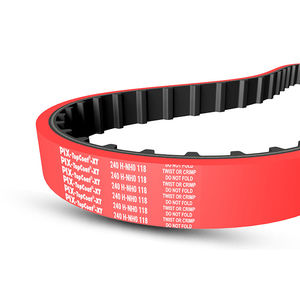
- Power Transmission - Mechanical components
- Mechanical Transmission
- Toothed belt
- PIX Transmissions Limited
- Company
- Products
- Catalogs
- News & Trends
- Exhibitions
Polyurethane belt PIX-X'pedient®-XTtimingfor machine toolsfor food industry machinery



Add to favorites
Compare this product
Characteristics
- Type
- timing
- Material
- polyurethane
- Product applications
- for machine tools, for food industry machinery, machine, for packaging machines, for robots, for medical devices, for pump
- Sector
- for the textile industry, for the food industry, for the packaging industry, medical
- Other characteristics
- low-noise, flexible, oil-resistant, abrasion-resistant, high-resistance, anti-vibration
- Length
Max.: 2,350 mm
(92.52 in)Min.: 120 mm
(4.72 in)- Thickness
2.2 mm, 2.7 mm, 4.5 mm
(0.09 in, 0.11 in, 0.18 in)- Pitch
5 mm, 10 mm
(0.197 in, 0.394 in)- Temperature
Max.: 110 °C
(230 °F)Min.: -30 °C
(-22 °F)
Description
Features:
• Highly flexible with longitudinal toughness to ensure perfect tooth meshing
• No dust-generation or flaking, while in operation
• Homogeneous, throughout its cross-section by virtue of thermoset moulding process
• Superior wear and abrasion resistance
• High resistance to oil and grease
• Excellent resistance to ageing, UV and ozone
• Low vibrations and reduced noise levels
• Operating temperature range: -30°C to +80°C (up to +110°C for a short period)
Constructional Details
1.Polyurethane Teeth offers low noise and wear resistance
2.High tensile steel cord tension member offers high dimensional stability
3.Polyurethane backing ensures superb resistance to adverse environmental conditions
Application:
Office automation equipment, vending machines, machine tools and pumps, textile machines, paper moulding and printing machinery, medical equipment, optical instruments, food processing units, packaging machinery, robotics, plotters, etc.
Catalogs
No catalogs are available for this product.
See all of PIX Transmissions Limited‘s catalogsOther PIX Transmissions Limited products
PIX-TIMING OR SYNCHRONOUS BELTS
Related Searches
- PIX transmission belt
- Flexible shaft coupling
- Shafts coupling
- Flange shaft coupling
- PIX industrial belt
- PIX rubber belt
- PIX plastic belt
- Transmission shaft coupling
- PIX toothed belt
- Compact shaft coupling
- PIX sturdy belt
- PU belt
- PIX poly V belt
- PIX synchronous belt
- Flat strip
- Misalignment correction shaft coupling
- High-torque shaft coupling
- Metal pulley
- Pump shaft coupling
- PIX oil-resistant belt
*Prices are pre-tax. They exclude delivery charges and customs duties and do not include additional charges for installation or activation options. Prices are indicative only and may vary by country, with changes to the cost of raw materials and exchange rates.








